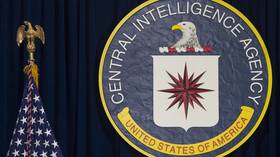Do You Think You’ll Ever Know, Now That You Have Handed Your Mind to the Machine?
We live in a 24/7 media society of the spectacle where brainwashing is cunning and relentless, and the consuming public is consumed with thoughts and perceptions filtered through electronic media according to the needs and lies of corporate state power.
This propaganda comes in two forms: covert and overt. The latter, and most effective form, comes with a large dose of truth offered rapid-fire by celebrated, authoritative voices via prominent media. The truth is sprinkled with subtle messages that render it sterile. This has long been the case, but it is even more so in the age of images on screens and digital media where words and images flow away like water in a rapidly moving stream. The late sociologist, Zygmunt Bauman, updating Marx’s famous quote “all that is solid melts into thin air,” called this “liquid modernity.”
Welcome to Operation Pandemonium
See, these experts purport to say: What we tell you is true, but it is impossible to draw definitive conclusions. You must drink the waters of uncertainty forever lest you become a conspiracy nut. But if you don’t want to be so labelled, accept the simplest explanation for matters that disturb you – Occam’s razor, that the truest answer is the simplest – which is always the official explanation. If this sounds contradictory, that is because it is. It is meant to be. We induce schizophrenia.
And it is, these experts suggest, because we live in a world where all knowledge is relative, and you, the individual, like Kafka’s country bumpkin, who in his parable “Before the Law,” tries to get past the doorkeeper to enter the inner sanctum of the Law but is never allowed to pass; you, the individual, must accept the futility of your efforts and accede to this dictum that declares that all knowledge is relative, which is ironically an absolute dictum. It is the Law. The Law of contradictions declared from on high.
Many writers, journalists, and filmmakers, while allegedly revealing truths about the U.S. and its allies’ criminal operations at home and abroad, have for decades slyly conveyed the message that in the end “we will never know the truth,” the real facts – that convincing evidence is lacking.
This refusal to come to conclusions is a sly tactic that keeps many careers safe while besmirching, intentionally or not, the names of serious researchers who reach conclusions based on overwhelming circumstantial evidence (the basis for most murder convictions) and detailed, sourced facts, often using the words of the guilty parties themselves, but are dismissed with the CIA weaponized term “conspiracy theorists.”
This often escapes the average person who does not read footnotes and sources, if they even read books. They read screens and the mainstream media, which should now be understood to include much of the “alternative” media. And they watch all sorts of films.
But this “we will never know” meme, this false mystery, is shrewdly and often implicitly joined to another: That we do know because the official explanation of events is true and only nut cases would believe otherwise. Propaganda by paradox. Operation chaos.
The JFK Assassination and the Release of Files
There are so many examples of this, with that of President Kennedy’s assassination being a foundational one. In this case, as with the current phony Trump release of more JFK assassination files, the ongoing “mystery” is always reinforced with the implicit or explicit presupposition that Lee Harvey Oswald killed Kennedy, but yet implying that there are more mysteries to explore forever because “people” are paranoid. (Trump’s position, as he recently told interviewer Clay Travis, is that he has always believed Oswald assassinated Kennedy, but he wonders if he may have had help.) They are paranoid not because of government and media lies, but because “popular culture” (not highbrow) has created paranoia. To spice this up, there is often the suggestion that President Kennedy was assassinated on the orders of the Mob, LBJ, Cuba, or Israel, when the facts overwhelmingly confirm it was organized and carried out by the CIA. A. O. Scott’s recent front page article in The New York Times in response to the JFK files release – “J. F. K., Blown Away, What Else Do I Have to Say?” (the title appropriately taken from a very fast-paced Billy Joel song and video) – is a perfect example of such legerdemain.
Thus the ruse to keep debating the assassination, get the latest documents, etc. to satisfy “people’s” insatiable paranoia. To pull out CIA fallback stories 2, 3, or even 4 when all else fails. Dr. Martin Schotz, the JFK researcher, rightly compares this to George Orwell’s definition of Crimestop:
‘Crimestop’ means the faculty of stopping short, as though by instinct, at the threshold of any dangerous thought. It includes the power of not grasping analogies, of failing to perceive logical errors, or misunderstanding the simplest arguments if they are inimical to [the powers that be]… and of being bored or repelled by any train of thought which is capable of leading in a heretical direction. ‘Crimestop’, in short, means protective stupidity.
It’s the crazy people’s fault, not Scott’s or those who back him up at The Times, a newspaper that has been lying about the JFK assassination from day one. The same goes for the assassinations of Malcolm X, Martin Luther King, Jr., Robert F. Kennedy, et al., and so many key events in U.S. history. It is a game of creating mental chaos by claiming we do know because the official explanation is correct but we don’t know because people have been infected with paranoia. If only people were not so paranoid! Unlike us at The Times, goes the implicit message.
The Epistemological Games of Certain Filmmakers
It is well known that people today are watching far more streaming film series and movies than they are reading books. That someone would lucubrate with pen in hand over a footnoted book on an important issue is now as rare as someone without a cell phone. The optical-electronic eye-ear screen connection rules most lives, mental and sensory. Marshall McLuhan, if a bit premature while referring in 1962 to Pierre Teilhard de Chardin – the French philosopher, paleontologist, and Jesuit priest – wrote sixty-three years ago in The Gutenberg Galaxy:
Instead of tending towards a vast Alexandrian library the world has become a computer, an electronic brain, exactly as an infantile piece of science fiction. And as our senses have gone outside us, Big Brother goes inside. [my emphasis] So, unless aware of this dynamic, we shall at once move into a phase of panic terrors, exactly befitting a small world of tribal drums, total interdependence, and superimposed co-existence.… Terror is the normal state of any oral society, for in it everything affects everything all the time.
Four years ago this month, I wrote an article – “You Know We’ll Never Know, Don’t You?” – about a new BBC documentary film series by the acclaimed British filmmaker, Adam Curtis, “Can’t Get You Out of My Head: An Emotional History of the Modern World.”
The series is a pastiche film filled with seven plus hours of fleeting, fragmented, and fascinating archived video images from the BBC archives where Curtis has worked for decades, accompanied by Curtis’s skeptical commentary about “a world where anything could be anything because there was no meaning anywhere.” These historical images jump from one seemingly disconnected subject to another to reinforce his point. He says it is “pointless to try to understand the meaning of why things happen.” He claims that we are all living as if we are “on an acid trip.”
While not on an acid trip which I have never taken, I was reminded of this recently as I watched a new documentary – Chaos: The Manson Murders (2025) – by the equally famous U.S. documentary filmmaker, Erroll Morris, a film about the CIA’s mind control operation, MKULTRA, and its use of LSD. As everyone knows, the CIA is that way-out hippie organization from Virginia that is always intent on spreading peace, love, and good vibes.
While the content of their films differs, Curtis’s wide-ranging and Morris’s focused on Manson and the book by Tom O’Neil, Chaos: Charles Manson, the CIA, and the Secret History of the Sixties, I was struck by both filmmakers tendency to obfuscate while titillating their audience with footage and information that belies their conclusions about not knowing. In this regard, Curtis is the most overt and extreme.
Morris does not use Curtis’s language, but he makes it explicit at Chaos’s end that he doesn’t believe Tom O’Neil’s argument in his well-researched book that Charles Manson was part of a CIA mind-control experiment led by the psychiatrist, Dr. Lewis Jolyon “Jolly” West. West worked in 1967 for the CIA on MKULTRA brainwashing projects in a Haight Ashbury clinic during the summer of love, using LSD and hypnosis, when Manson lived there and was often in the clinic with his followers.
On April 26, 1964, West also just “happened” to visit the imprisoned Jack Ruby, the man who killed Lee Harvey Oswald in the Dallas Police Department, and when West emerged from the meeting, he immediately declared that in the preceding 48 hours Ruby had become “positively insane” with no chance that this “unshakeable” and “fixed” lunacy could be reversed. What happened between the two men we do not know – for there were no witnesses – but one might assume West used his hypnotic skills and armamentarium of drugs that were integral to MKULTRA’s methods.
MKULTRA
MKULTRA was a sinister and secret CIA mind-control project, officially started in 1953 but preceded by Operation Bluebird, which was renamed Operation Artichoke. These operations started right after WW II when U.S. intelligence worked with Nazi doctors to torture Russians and others to reveal secrets. They were brutal. MKULTRA was run by Dr. Sidney Gottlieb and was even worse. He was known as the “Black Sorcerer.” With the formula for LSD, the CIA had an unlimited amount of the drug to use widely, which it did. It figured prominently in MKULTRA mind control experiments along with hypnosis. Tom O’Neil sums it up thus:
The agency hoped to produce couriers who could imbed hidden messages in their brains, to implant false memories and remove true ones in people without their awareness, to convert groups to opposing ideologies, and more. The loftiest objective was the creation of hypno-programmed assassins. . . . MKULTRA scientists flouted this code [the Nuremberg Code that emerged from the Nuremberg trials of Nazis] constantly, remorselessly – and in ways that stupefy the imagination. Their work encompassed everything from electronic brain stimulation to sensory deprivation to ‘induced pain’ and ‘psychosis.’ They sought ways to cause heart attacks, severe twitching, and intense cluster headaches. If drugs didn’t do the trick, they’d try master ESP, ultrasonic vibrations, and radiation poisoning. One project tried to harness the power of magnetic fields. [my emphasis]
In 1973 during the Watergate scandal, CIA Director William Helms ordered all MKULTRA documents destroyed. Most were, but some were forgotten, and in the next few years, Seymour Hersh reported about it and the Senate Church Committee went further. They discovered records that implicated forty-four universities and colleges in the experiments, eighty institutions, and 185 researchers, Louis West among them. The evil cat and its large litter were out of the bag.
MKULTRA allegedly ended in 1973. But only the most naïve would think it did not continue under a different form. In 1964, McLuhan wrote that “the medium is the message.” The new medium that was developed in the decades since has been effectively pointed straight at the brain as you watch the screens. And the message?
Tom O’Neil’s Powerful Case
While admitting that he has not conclusively proven his thesis because he has never been able to confirm Manson and West being together, O’Neil amasses a tremendous amount of convincing circumstantial evidence in his book that makes his case very strong that they were, and that Manson’s ability to get his followers to kill for him was the result of MKULTRA mind control and the use of LSD, which he used extensively and which was introduced by the CIA and used by West. Both men had an inexhaustible amount of the mind-altering drug to use on their victims.
This is the subject of Morris’s film, wherein he interviews O’Neil on camera, who explains the extraordinary fact that Manson was able to mesmerize his followers to kill for him without remorse or shame. They “couldn’t get him out of their heads,” even many years later. This was, of course, the goal of MKULTRA – through the use of brainwashing and drugs – to create “Manchurian Candidates.” This case has much wider ramifications than the sensational 1969 Hollywood murders for which Manson and his followers were convicted; for clearly Mansion’s “family” that carried out the murders on his orders appeared in every way to be under hypnotic control. How did a two-bit, ex-con, pipsqueak, minor hanger-on musician learn to accomplish exactly what MKULTRA spent so many years working on?
Yet at the end of his film, Morris makes a concluding comment without even a nod to the possibility that O’Neil is correct. He says he doesn’t believe O’Neil. I found it very odd, jarring, as though O’Neil had been set up for this denouement, which I think he had. But at the same time I recognized it as Morris’s method of setting up and then undermining the narrative protagonists in his films that are ostensibly about getting to factual truths but never do; they are stories about how all we ever have are endless interpretations and the unknowable, confounded by human fallibility. Everything is lost in the fog of Morris’s method, which is no accident.
Frank Olson
I then found an interview that O’Neil did in 2021 in which he said he pulled out of Morris’s film proposal because Morris wanted to make a film that combined the Frank Olson story (a CIA biologist) with his about Manson. In the interview, O’Neil said he knew Eric Olson, Frank Olson’s son, who has spent a lifetime proving that the CIA murdered his father in 1953, but he didn’t explain why he pulled out of the project. However, he appears extensively throughout Chaos, being interviewed on camera by Morris, only to be undermined at the end. Why he eventually agreed to be part of the project I do not know.
I am certain he has seen Wormwood (2017), Morris’s acclaimed (they are all acclaimed) Netflix film series about the biologist/ CIA agent Frank Olson and his son, Eric Olson’s heroic lifelong quest to prove that the CIA murdered his father because he had a crisis of conscience about the agency’s use of torture, brainwashing, LSD, and U.S. biological weapons use in Korea, much of it in association with Nazis. The evidence is overwhelming that Frank Olson did not jump from a NYC hotel window in 1953 but was drugged with LSD to induce hallucinations and paranoia, smashed in the head, and thrown out by the CIA. [Read this and view this] Despite such powerful evidence available to him before making Wormwood, in another example of Morris’s method, he disagrees with Eric Olson’s decades of conclusive research that his father was murdered.
Conclusion
Filmmakers like Adam Curtis and Erroll Morris are examples of a much larger and dangerous phenomenon. Their emphases on the impossibility of knowing – this seeming void in the human mind, an endless acid trip down a road of kaleidoscopic interpretations – is much larger than them. It is deeply imbedded in today’s society. One of the few areas in which we are said to be able to know anything for certain is in the area of partisan politics. Here knowingness is the rule and the other side is always wrong. Fight, fight, fight for the home team! Here the nostalgia for “knowledge” is encouraged, as if we don’t live in a 24/7 media society of the spectacle where brainwashing is cunning and relentless, and the consuming public is consumed with thoughts and perceptions filtered through electronic media according to the needs and lies of corporate state power.
With the arrival of the electronic digital life, “knowledge” is now screening. If you don’t want to confirm McLuhan’s prediction – “as our senses have gone outside us, Big Brother goes inside” – it behooves everyone to step back into the lamplight to read and study books. And take a walk in nature without your machine. You might hear a little bird call to you.







